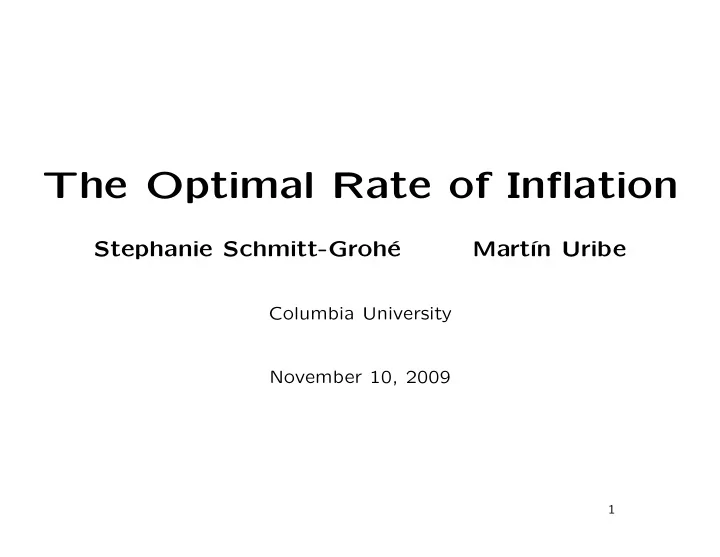

The Optimal Rate of Inflation Stephanie Schmitt-Groh´ e Mart ´ ın Uribe Columbia University November 10, 2009 1
Inflation Targets Around the Industrial World Inflation Target Country (percent per year) New Zealand 1-3 Canada 1-3 United Kingdom 2 Australia 2-3 Sweden 2 ± 1 Switzerland < 2 Iceland 2.5 Norway 2.5 Source: World Economic Outlook 2005. 2
Motivating Question Are observed magnitudes of inflation targets (2 percent or higher) consistent with the optimal rate of inflation predicted by leading theories of monetary non-neutrality? 3
Two Key Sources of Monetary Nonneutrality Source Optimal Inflation Target Demand for Money - r Sticky Prices 0 4
Deviations from the Friedman Rule within the Money-Demand Model • Distortionary Taxation: Friedman rule still optimal (con- trary to Phelps’ 1973 conjecture) • Untaxed Income: Small deviations from Friedman rule. – Untaxed Profits – Tax Evasion 5
A Foreign Demand for Domestic Money • Motivating Fact: More than 50% of US currency cir- culates abroad • Ramsey Optimal Inflation Target with a Foreign De- mand for Domestic Currency Optimal Inflation M f M f + M d Target Pc M f + M d No Foreign Demand: 0 0.27 -3.9% Foreign Demand: 0.22 0.26 +2.1% • Caveat This argument does not apply to countries lacking a foreign demand for their currency. 6
Friedman-Rule Versus Price-Stability Tradeoff (or Money Demand Meets Sticky Prices) 0 −0.5 Optimal Inflation Target −1 −1.5 −2 −2.5 −3 0 0.2 0.4 0.6 0.8 1 Degree of Price Stickiness ( α ) 7
Friedman-Rule Versus Price-Stability Tradeoff with Optimal Distortionary Taxation Phelps’ conjecture resurrected 0 Optimal Inflation Target −0.5 −1 −1.5 −2 −2.5 −3 0 0.2 0.4 0.6 0.8 1 Degree of Price Stickiness ( α ) 8
Does the Zero Bound Provide a Rationale for Positive Inflation Targets? • Strategy: Build medium-scale macroeconomic model esti- mated on U.S. data. • Compute Ramsey optimal monetary policy. • Finding: mean( π ) = -0.4%; mean( R ) = 4.4%; std( R ) = 0.9. ⇒ R must fall 4 stds to hit zero bound • Under optimal policy hitting zero bound is unlikely. 9
Downward Nominal Rigidity The Issue: If nominal prices are downwardly rigid, then any change in relative prices requires an increase in the nominal price level. (Structural inflationary pressure. Olivera, OEP , 1964.) The Question: What is the optimal structural rate of inflation? The model:— Neo-Keynesian framework with price and wage rigidity, no capital and no demand for money. Wage adjustment costs are asymmetric. (Kim and Ruge Murcia, 2009). Answer: The optimal structural rate of inflation is 0.35 percent per year. Not large enough to explain observed inflation targets of 2 percent. 10
Quality Bias Firms produce c it = z t F ( h it ) and sell it for P it dollars. � 1 / (1 − 1 /η ) and de- �� 1 0 ( x it c it ) 1 − 1 /η di Households care about a t ≡ � ˜ � 1 − η a t P it mand c it = x it . ˜ P t The exogenous variable x it = (1 + κ ) x it − 1 captures quality im- provement. ˜ P it ≡ P it /x it is the quality-adjusted (or hedonic) price of c it . ˜ P t is an index of quality-adjusted (or hedonic) prices. 11
The Optimal Rate of Inflation under Qual- ity Bias Stickiness in Optimal Inflation Rate Nonquality-Adjusted Prices, P it 0 Hedonic Prices, ˜ P it κ The parameter κ > 0 denotes the rate of quality improvement. 12
Conclusions The theories reviewed in this chapter suggest that • there is little theoretical support for infla- tion targets as high as 2% per year. • the optimal inflation target is around zero. 13
Recommend
More recommend